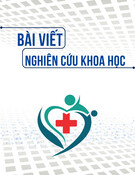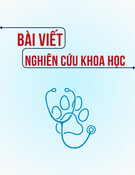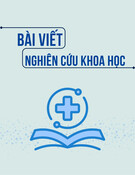
vietnam medical journal n01 - DECEMBER - 2024
284
Southeast Asian region. JGH Open, 2021. 5(8): p.
855-863.
2. Davis, T.A. and C.P. Gyawali, Refractory
Gastroesophageal Reflux Disease: Diagnosis and
Management. J Neurogastroenterol Motil, 2024.
30(1): p. 17-28.
3. Cui, N., et al., Laryngopharyngeal reflux disease:
Updated examination of mechanisms,
pathophysiology, treatment, and association with
gastroesophageal reflux disease. World J
Gastroenterol, 2024. 30(16): p. 2209-2219.
4. Katz, P.O., et al., ACG Clinical Guideline for the
Diagnosis and Management of Gastroesophageal
Reflux Disease. Am J Gastroenterol, 2022. 117(1):
p. 27-56.
5. Armstrong, D., Endoscopic evaluation of gastro-
esophageal reflux disease. Yale J Biol Med, 1999.
72(2-3): p. 93-100.
6. Gyawali, C.P., et al., Modern diagnosis of
GERD: the Lyon Consensus. Gut, 2018. 67(7): p.
1351-1362.
7. Ates, F. and M.F. Vaezi, Approach to the
patient with presumed extraoesophageal GERD.
Best Pract Res Clin Gastroenterol, 2013. 27(3): p.
415-31.
8. Zelenik, K., et al., There is no correlation
between signs of reflux laryngitis and reflux
oesophagitis in patients with gastro-oesophageal
reflux disease symptoms. Acta Otorhinolaryngol
Ital, 2017. 37(5): p. 401-405.
9. Jaspersen, D., et al., Prevalence of extra-
oesophageal manifestations in gastro-
oesophageal reflux disease: an analysis based on
the ProGERD Study. Aliment Pharmacol Ther,
2003. 17(12): p. 1515-20.
10. Dy, F., et al., Salivary Pepsin Lacks Sensitivity as
a Diagnostic Tool to Evaluate Extraesophageal
Reflux Disease. J Pediatr, 2016. 177: p. 53-58.
ĐẶC ĐIỂM CHÊNH LỆCH CHIỀU DÀI CHI DƯỚI VÀ CHỨC NĂNG
KHỚP HÁNG Ở NGƯỜI BỆNH SAU MỔ THAY KHỚP HÁNG
TOÀN PHẦN HAI BÊN TẠI BỆNH VIỆN ĐẠI HỌC Y HÀ NỘI
Đỗ Văn Minh1,2, Nguyễn Huy Phương1,2, Trần Xuân Lộc3
TÓM TẮT69
Mục tiêu: 1. Mô tả đặc điểm chênh lệch chiều
dài chi dưới ở người bệnh sau mổ thay khớp háng
toàn phần hai bên. 2. Đánh giá chức chức năng khớp
háng người bệnh sau mổ thay khớp háng toàn phần
hai bên tại Bệnh viện Đại Học Y Hà Nội. Đối tượng
và phương pháp nghiên cứu: Nghiên cứu mô tả 83
người bệnh, gồm 71 nam và 12 nữ, có độ tuổi trung
bình 51,7 ± 13,3 tuổi, trong đó có 71 người bệnh bị
hoại tử chỏm xương đùi và 12 người bệnh bị thoái hóa
khớp háng hai bên, đuợc phẫu thuật thay khớp háng
toàn phần lần lượt từng bên một tại Bệnh viện Đại học
Y Hà Nội từ tháng 1 năm 2021 đến tháng 1 năm 2024.
Kết quả phẫu thuật được đánh giá sau mổ ít nhất 6
tháng. Chênh lệch chiều dài chi dưới được đánh giá
trên lâm sàng và X quang khung chậu tư thế thẳng
tiêu chuẩn. Chức năng khớp háng người bệnh được
đánh giá bằng thang điểm Oxford Hip Sccore (OHS).
Kết quả nghiên cứu: 34/49 (40,9) người bệnh có
cảm nhận chênh lệch chiều dài chi dưới sau mổ.
Chênh lệch chiều dai chi dưới đo trên lâm sàng là 9,15
±6,47 mm (0-20), X quang là 6,05 ± 3,77mm (0-19).
Điểm OHS trung bình sau mổ là 45,98 ±2,69 (38- 48).
Không có sự liên quan giữa mức độ chênh lệch chiều
dài chi dưới và điểm OHS. Kết luận: Người bệnh sau
phẫu thuật thay khớp háng toàn phần hai bên có mức
1Trường Đại học Y Hà Nội
2Bệnh viện Đại học Y Hà Nội
3Bệnh viện Bưu điện
Chịu trách nhiệm chính: Đỗ Văn Minh
Email: minhdovan@hmu.edu.vn
Ngày nhận bài: 13.9.2024
Ngày phản biện khoa học: 24.10.2024
Ngày duyệt bài: 25.11.2024
độ chênh lệch chiều dài chi dưới không nhiều và chức
năng khớp háng tốt.
Từ khóa:
Thay khớp háng toàn phần, chênh lệch
chiều dài chi dưới, chức năng khớp háng.
SUMMARY
CHARACTERISTIC OF LOWER LIMB
LENGTH DISCREPANCY AND HIP
FUNCTION FOLLOWING BILATERAL TOTAL
HIP ARTHROPLASTY AT HANOI MEDICAL
UNIVERSITY HOSPITAL
Objectives: 1. To describe the characteristics of
leg length discrepancy in patients after bilateral total
hip arthroplasty. 2. To evaluate the patient's hip
function after bilateral total hip arthroplasty at Hanoi
Medical University Hospital. Materials and methods:
A descriptive cross-sectional study involving 64
patients, including 71 men and 12 women, with an
average age of 51.7 ± 13.3 years, of which 71
patients have avascular osteonecrosis of the femoral
head and 12 patients with bilateral hip osteoarthritis
underwent total hip arthroplasty one by one at Hanoi
Medical University Hospital from January 2021 to
January 2024. The surgical outcomes were evaluated
for at least six months after surgery. Leg length
discrepancy was assessed clinically and
radiographically. The Oxford Hip Score (OHS) was
used to evaluate patients' hip function. Results:
34/49 (40.9) patients felt a difference in lower limb
length after surgery. The difference in lower limb
length measured clinically is 9.15 ± 6.47 mm (0-20),
X-ray is 6.05 ± 3.77mm (0-19). The average OHS
after surgery was 45.98 ±2.69 (38- 48). There is no
relation between leg length discrepancy and OHS.
Conclusion: Patients following bilateral total hip

TẠP CHÍ Y häc viÖt nam tẬP 545 - th¸ng 12 - sè 1 - 2024
285
replacement surgery have a slight leg length
discrepancy and good hip function.
Keywords:
Total hip arthroplasty, leg length
discrepancy, hip function.
I. ĐẶT VẤN ĐỀ
Chênh lệch chiều dài (CLCD) chi dưới là biến
chứng thường gặp nhất của phẫu thuật thay
khớp háng toàn phần1. CLCD chi dưới sau mổ
thay khớp háng toàn phần không chỉ đơn thuần
là sự khác biệt chiều dài giải phẫu của chi dưới
mà còn có thể là hậu quả của co cơ do đau hoặc
co rút phần mềm quanh khớp háng do bản chất
bệnh lý của khớp háng. Không có số liệu chính
xác về tỷ lệ hiện mắc của CLCD chi dưới sau mổ
thay khớp háng toàn phần nhưng tỷ lệ mắc mới
hàng năm được ghi nhận lên đến lên đến
27%1,2. Mặc dù vậy chỉ khoảng 1/3 tổng số
trường hợp CLCD chi dưới trên 1cm sau mổ thay
khớp háng toàn phần có biểu hiện triệu chứng
lâm sàng. CLCD chi dưới có biểu hiện lâm sàng
thường khiến người bệnh không hài lòng về kết
quả phẫu thuật. Hậu quả của CLCD chi dưới có
thể khiến người bệnh phải mang giày chỉnh hình
hoặc mổ lại. Bên cạnh đó, CLCD chi dưới có biểu
hiện lâm sàng thường là nguyên nhân căng
thẳng trong mối quan hệ thầy thuốc- người
bệnh, có thể dẫn đến khiếu kiện kéo dài. Kiểm
soát chiều dài chi trong và sau mổ thay khớp
háng toàn phần là điều hết sức cần thiết nhằm
hạn chế tình trạng CLCD chi dưới. Nhiều nghiên
cứu về CLCD chi dưới, cách thức phòng ngừa và
điều trị CLCD chi dưới cũng như ảnh hưởng của
CLCD chi dưới đến chức năng khớp háng, chất
lượng cuộc sống và mức độ hài lòng của người
bệnh đã được ghi nhận trên y văn, tuy nhiên mới
chỉ tập trung chủ yếu vào nhóm người bệnh sau
mổ thay khớp háng toàn phần một bên. Theo
hiểu biết của chúng tôi, cho đến nay không có
những báo cáo về tình trạng CLCD chi dưới sau
mổ thay khớp háng toàn phần hai bên được ghi
nhận trên y văn.
Các trung tâm chấn thương chỉnh hình ở các
nước phát triển thường áp dụng nhiều biện pháp
khác nhau để kiểm soát chiều dài chi cho bệnh
nhân mổ thay khớp háng toàn phần, bao gồm
việc lập kế hoạch trước mổ và lựa chọn cấu hình
khớp háng phù hợp với khớp háng thật của
người bệnh, sử dụng thiết bị định vị hoặc rô bốt
hỗ trợ trong mổ… Tại Việt Nam, những hạn chế
về trang thiết bị hiện đại để kiểm soát chiều dài
chi trong mổ cùng với việc sử dụng cấu hình
khớp háng khác nhau cho một người bệnh được
thay khớp háng toàn phần hai bên làm tăng
nguy cơ CLCD chi dưới sau mổ. Để tìm hiểu thực
tế vấn đề này, cũng như đánh giá tổng kết kinh
nghiệm thực tiễn điều trị phẫu thuật thay khớp
háng toàn phần hai bên ở bệnh viện Đại học Y
Hà Nội, chúng tôi tiến hành nghiên cứu đề tài
này nhằm mô tả đặc điểm CLCD chi dưới và
đánh giá chức năng khớp háng của người bệnh
sau mổ thay khớp háng toàn phần hai bên tại
Bệnh viện Đại học Y Hà Nội.
II. ĐỐI TƯỢNG VÀ PHƯƠNG PHÁP NGHIÊN CỨU
2.1. Đối tượng nghiên cứu. Gồm 83 người
bệnh được phẫu thuật thay khớp háng toàn phần
hai lần từng bên một tại Khoa Chấn thương chỉnh
hình và Y học thể thao- Bệnh viện Đại Học Y Hà
Nội từ tháng 1 năm 2021 đến tháng 1 năm 2024.
2.1.1. Tiêu chuẩn chọn người bệnh
Người bệnh bị hoại tử chỏm xương đùi 2
bên hoặc thoái hóa khớp háng 2 bên được phẫu
thuật thay khớp háng toàn phần từng bên một.
Có đủ hồ sơ bệnh án, chụp phim X quang
trước và sau mổ.
Người bệnh được khám lại lâm sàng và
chụp X quang để đánh giá CLCD chi dưới và
chức năng khớp háng sau mổ lần thứ hai (khớp
háng thứ hai) ít nhất 6 tháng.
2.1.2. Tiêu chuẩn loại trừ
Người bệnh bị viêm cột sống dính khớp.
Người bệnh có tiền sử gãy xương và/ hoặc
trật khớp chi dưới.
Người bệnh có tiền sử mổ cột sống hoặc
bệnh lý thần kinh chi dưới.
2.2. Phương pháp nghiên cứu
2.2.1. Phương pháp nghiên cứu
Thiết kế nghiên cứu: Nghiên cứu tiến cứu
mô tả cắt ngang.
Cỡ mẫu nghiên cứu: Cỡ mẫu toàn bộ, chọn
mẫu thuận tiện.
2.2.2. Các biến số nghiên cứu
Đặc điểm chung của nhóm nghiên cứu:
tuổi, giới, bệnh lý, thời gian theo dõi.
CLCD chi trên lâm sàng, trên X quang.
Chức năng khớp háng đánh giá theo tháng
điểm Oxford Hip Score.
2.2.3. Các bước tiến hành nghiên cứu
Lập danh sách những người bệnh đã mổ
thay khớp háng toàn phần hai bên tại Bệnh viện
Đại học Y Hà Nội từ tháng 1 năm 2021 đến
tháng 1 năm 2024.
Tra cứu thông tin người bệnh qua bệnh án
điện tử để lấy các thông tin về bệnh, phẫu thuật,
các phim chụp trước mổ và ngay sau mổ.
Chọn những người bệnh có đủ tiêu chuẩn
lựa chọn và thỏa mãn tiêu chuẩn loại trừ.
Thu thập các thông tin về bệnh lý khớp
háng, phẫu thuật, loại khớp nhân tạo được phẫu

vietnam medical journal n01 - DECEMBER - 2024
286
thuật, các biến chứng trong và sau phẫu thuật,
phục hồi chức năng sau phẫu thuật.
Mời người bệnh đến khám lại tại Bệnh viện
Đại học Y Hà Nội.
Khi người bệnh tái khám sẽ thu thập thông
tin theo biểu mẫu nghiên cứu bao gồm hỏi các
triệu chứng, khám lâm sàng toàn diện và chụp
phim X-quang khung chậu thẳng tiêu chuẩn tư
thế đứng theo mẫu bệnh án nghiên cứu thống
nhất nhằm thu thập các thông tin phục vụ cho
nghiên cứu.
Đánh giá CLCD chi dưới lâm sàng bằng
cách đo chiều dài cấu trúc chi dưới. Chiều dài cấu
trúc chi dưới được đo bằng thước dây, tính theo
đơn vị mm, khoảng cách từ gai chậu trước trên
đến đỉnh mắt cá trong ở tư thế người bệnh nằm
ngửa, khớp háng và khớp gỗi duỗi, khớp cổ chân
ở tư thế trung gian, hai chân khép song song với
thân mình. CLCD cấu trúc hai chân được xác định
là CLCD chi dưới (tính theo đơn vị mm).
Đánh giá CLCD chi dưới X quang trên X-
quang khung chậu thẳng tiêu chuẩn theo
phương pháp đo của Williamson và Reckling.
Hình 1: Đo chênh lệch chiều dài chi trên X
quang khung chậu thẳng
Chức năng khớp háng của người bệnh
được đánh giá theo thang điểm Oxford Hip Score
(OHS). Thang điểm OHS gồm 12 câu hỏi, được
thiết kế để đánh giá mức độ đau và chức năng
khớp háng người bệnh sau mổ thay khớp háng.
Mỗi câu hỏi được cho điểm trong khoảng từ 0-4
với 0 là kết quả tệ nhất và 4 là kết quả tốt nhất.
Điểm OHS càng cao nghĩa là người bệnh đau
càng ít và chức năng khớp háng càng tốt.
2.3. Xử lý số liệu. Số liệu được nhập liệu
và xử lý dựa vào phần mềm SPSS 26.0. Các biến
số phân loại được trình bày dưới dạng tỷ lệ. Các
biến số liên tục được trình bày dưới dạng trung
bình ± độ lệch chuẩn. Các test nghiên cứu: T
test, Correlate với p< 0,05 là sự khác biệt có ý
nghĩa thống kê.
III. KẾT QUẢ NGHIÊN CỨU
3.1. Đặc điểm chung của ngóm nghiên cứu
Bảng 1. Đặc điểm chung của nhóm
nghiên cứu (n=83)
Đặc điểm nghiên cứu
Số
NB
Tỷ lệ
%
Tuổi
Dưới 40 tuổi
18
21,7
40-60 tuổi
40
48,2
Trên 60 tuổi
25
30,1
Trung bình ± Độ lệch
chuẩn
51,7 ± 13,3
tuổi
Giới
Nam
71
85,5
Nữ
12
14,5
Chẩn
đoán
Hoại tử vô khuẩn chỏm
xương đùi
76
91,6
Thoái hóa khớp háng
7
8,4
Thời
gian
theo dõi
sau mổ
Từ 6 đến dưới 12 tháng
34
41,0
12- 24 tháng
36
43,4
Trên 24 tháng
13
15,6
Trung bình ± Độ lệch
chuẩn
17,7 ± 7,99
tháng
3.2. Đặc điểm CLCD chi dưới ở người
bệnh sau mổ thay khớp háng toàn phần hai
bên
Bảng 2. Đặc điểm CLCD chi dưới sau mổ
thay khớp háng toàn phần hai bên (n=83)
Đặc điểm nghiên cứu
Số
NB
Tỷ lệ
%
Cảm nhận
của NB về
CLCD chi
dưới khi đi lại
Có cảm nhận thấy
CLCD chi dưới
34
40,9
Không cảm nhận
thấy CLCD chi dưới
49
59,1
CLCD chi
dưới lâm
sàng
Không CLCD chi
25
30,1
CLCD chi dưới 10 mm
41
49,4
CLCD chi trên 10 mm
17
20,5
Trung bình ± Độ lệch
chuẩn (Min-Max)
9,15±6,47
(mm) (0-20)
CLCD chi
dưới X
quang
Không CLCD chi
7
8,4
CLCD chi dưới 10 mm
64
77,1
CLCD chi trên 10 mm
12
14,5
Trung bình ± Độ lệch
chuẩn (Min-Max)
6,05±3,77
(mm) (0-19)
3.3. Chức năng khớp háng của người
bệnh sau mổ thay khớp háng toàn phần hai
bên
Bảng 3. Chức năng khớp háng người
bệnh sau mổ thay khớp háng toàn phần hai
bên (n=83)
Điểm OHS
Số người bệnh
Tỷ lệ %
Từ 40-48 điểm
79
95,2
Từ 30-39 điểm
4
4,8
Dưới 29 điểm
0
0
Trung bình ± Độ lệch
chuẩn (Min- Max)
45,98 ±2,69 (38- 48)
3.4. Mối quan hệ giữa chức năng khớp
háng với CLCD chi dưới
Bảng 4. Mối liên quan giữa chức năng

TẠP CHÍ Y häc viÖt nam tẬP 545 - th¸ng 12 - sè 1 - 2024
287
khớp háng với tình trạng CLCD chi dưới
(n=83)
Điểm OHS
CLCD chi dưới
lâm sàng
CLCD chi dưới
X quang
Dưới
10 mm
Trên
10 mm
Dưới
10 mm
Trên
10 mm
Trung bình ±
Độ lệch chuẩn
45,9 ±
2,27
43,2 ±
1,99
46,6 ±
2,37
42,4 ±
1,51
p
p < 0.05
p < 0.05
IV. BÀN LUẬN
Không còn nghi ngờ gì, y văn đã khẳng định
rằng khó có thể đạt được sự cân bằng tuyệt đối
về chiều dài chi và không thể loại bỏ được CLCD
chi sau mổ thay khớp háng. Tỷ lệ CLCD chi sau
mổ thay khớp háng được báo cáo rất giao động,
từ khoảng 1- 27% với mức độ CLCD chi cũng rất
thay đổi, từ 3- 70mm, và mức độ CLCD chi trung
bình khoảng 3-17mm1,2. CLCD chi sau mổ thay
khớp háng có liên quan đến đau lưng, đau thần
kinh tọa, thay đổi dáng đi, trật khớp nhân tạo,
lỏng khớp nhân tạo và sự không hài lòng của
người bệnh và phẫu thuật lại3.
Nghiên cứu của chúng tôi ghi nhận 69,9%
người bệnh có biểu hiện CLCD chi dưới trên lâm
sàng và 91,6% người bệnh có biểu hiện CLCD
chi dưới trên X quang. Mức độ CLCD chi dưới
lâm sàng sau mổ trung bình là 9,15 ±6,47 (mm)
và mức độ CLCD chi dưới X quang sau mổ trung
bình là 6,05 ± 3,774(mm). Sở dĩ có sự khác
nhau giữa CLCD chi dưới khi đo trên lâm sàng và
đo trên X quang bởi có sự khác nhau về tư thế
bệnh nhân khi đo, mốc giải phẫu và cách đo. Tuy
nhiên một vấn đề được ghi nhận là với cả hai
cách đo trên, không có người bệnh nào có CLCD
chi trên 20mm. Một số nghiên cứu đánh giá CLCD
chi dưới sau mổ thay khớp háng một bên cũng chỉ
ra tỷ lệ CLCD chi dưới cao: nghiên cứu của
Konyves và cs ghi nhận tỷ lệ CLCD chi dưới lên
đến 94% trong đó tỷ lệ chân mổ dài hơn chân
không mổ là 62% và tỷ lệ chân mổ ngắn hơn
chân chưa mổ là 32%, nghiên cứu của Weng và
cs ghi nhận tỷ lệ CLCD chi dưới là 81,3% trong đó
tỷ lệ chân mổ dài hơn chân không mổ là 65% và
tỷ lệ chân mổ ngắn hơn chân chưa mổ là 16,3%2.
Thông thường, khoảng 50% người bệnh thay
khớp háng toàn phần một bên có mức CLCD chi
dưới ≥ 10mm nhưng chỉ có khoảng 10-20% phải
điều trị bằng giày chỉnh hình4. Nghiên cứu của
Love và Wright cho thấy có tới 18% người bệnh
có CLCD chi dưới hơn 1,5 cm, trong đó 6% cần
chỉnh sửa bằng cách đeo giày chỉnh hình trong khi
Williamson và Reckling đã báo cáo CLCD chi dưới
trung bình sau mổ thay khớp háng là 16 mm và
có tới 27% bệnh nhân cần chỉnh sửa bằng cách đi
giày chỉnh hình2.
Phẫu thuật thay khớp háng đã được coi là
phẫu thuật của thế kỷ XX khi nó đem lại chức
năng khớp háng và chất lượng cuộc sống tuyệt
vời cho người mắc các bệnh lý khớp háng giai
đoạn muộn. Theo nghiên cứu của chúng tôi,
điểm OHS trung bình là 45,98 ±2,69 (38- 48),
điều này thể hiện tất cả các bệnh nhân sau mổ
đều có chức năng khớp háng tốt. Mặc dù có
chức năng khớp háng ở mức tốt nhưng cảm
nhận về CLCD chi dưới sau khi phẫu thuật
thường được bệnh nhân chú ý. Đa số các nghiên
cứu cho rằng, người bệnh dễ dàng dung nạp với
mức CLCD chi dưới dưới 10mm. Tuy nhiên, CLCD
chi dưới dù ở mức độ ít nhưng nếu bệnh nhân
cảm nhận được cũng ảnh hưởng đến sự hài lòng
của bệnh nhân.Trong nghiên cứu của chúng tôi
có 40,96% trường hợp có cảm nhận được CLCD
chi dưới sau phẫu thuật. Wylde và cộng sự ghi
nhận tỷ lệ bệnh nhân cảm nhận được so le chân
là 30% ở thời điểm 5-8 năm sau phẫu thuật và
trong số những trường hợp so le chân, có 49%
cảm thấy bị phiền toái khi có biến chứng này và
31% phải mang giầy có độn gót để hai chân
bằng nhau5. Một số nghiên cứu về phẫu thuật
thay khớp háng toàn phần một bên đã chỉ ra
rằng 6-32% người bệnh có thể cảm nhận được
CLCD chi dưới sau mổ thay khớp háng khi bên
phẫu thuật có chiều dài ngắn hơn bên không
phẫu thuật 10mm hoặc dài hơn bên không phẫu
thuật 6mm2. Điều đáng quan tâm nữa là liệu có
sự liên quan giữa việc CLCD chi dưới và chức
năng khớp háng của người bệnh trong nhóm
bệnh nhân nghiên cứu? Trong nghiên cứu của
chúng tôi ghi nhận những bệnh nhân có CLCD
chi dưới lâm sàng và X quang dưới 10 mm có
điểm OHS trung bình cao hơn nhóm bệnh nhân
có CLCD chi dưới lâm sàng và X quang trên
10mm. Mặc dù chênh lệch điểm không nhiều
nhưng sự khác biệt này có ý nghĩa thống kê với
p< 0.05. Điều đó cho thấy, ở bệnh nhân thay
khớp háng, nếu cân bằng chiều dài chi dưới càng
tốt thì chức năng khớp háng người bệnh càng
cao. Mối liên quan giữa chức năng khớp háng và
CLCD chi dưới đã được ghi nhận ở nhiều nghiên
cứu báo cáo về những bệnh nhân thay khớp
háng toàn phần một bên: Knoyves và Bannister
cho biết 33% bệnh nhân trong nghiên cứu cảm
nhận được sự dài chi và 18% bệnh nhân có điểm
OHS ở mức thấp nhất là nhóm bệnh nhân có
cảm nhận thấy sự CLCD chi dưới, Wydle và cộng
sự cũng ghi nhận người bệnh có CLCD chi dưới
sau mổ thay khớp háng có điểm OHS thấp hơn
và có dáng đi khập khiễng cao hơn3,4, 6-8. Mặc dù

vietnam medical journal n01 - DECEMBER - 2024
288
vậy, theo hiểu biết của chúng tôi hiện chưa có
báo cáo nào đánh giá CLCD chi dưới ở bệnh
nhân thay khớp háng toàn phần hai bên cũng
như ảnh hưởng của CLCD chi dưới đến chức
năng khớp háng sau mổ. Hạn chế trong nghiên
cứu của chúng tôi là cỡ mẫu còn bé và chỉ thực
hiện duy nhất ở một bệnh viện. Để có cái nhìn
khái quát hơn, cần thực hiện nghiên cứu với cỡ
mẫu lớn hơn và ở đa trung tâm.
V. KẾT LUẬN
CLCD chi dưới là một biến chứng phổ biến
sau phẫu thuật thay khớp háng toàn phần hai
bên. Mặc dù vậy, mức độ CLCD chi dưới lâm
sàng và X quang đều không nhiều, hầu hết dưới
20mm. Trong giới hạn ấy, mức độ CLCD chi dưới
càng ít thì chức năng khớp háng càng tốt.
TÀI LIỆU THAM KHẢO
1. Saurabh Khakharia and William A. Jiranek
(2013), Leg length inequality: prevention/
treatment, Surgery of the hip, Elsevier saunders,
1245- 1252.
2. Desai AS, Dramis A, Board TN. Leg length
discrepancy after total hip arthroplasty: a review
of literature. Curr Rev Musculoskelet Med. 2013;
6(4):336-341. doi:10.1007/s12178-013-9180-0
3. Röder C, Vogel R, Burri L, Dietrich D, Staub
LP. Total hip arthroplasty: leg length inequality
impairs functional outcomes and patient
satisfaction. BMC Musculoskelet Disord.
2012;13(1):95. doi:10.1186/1471-2474-13-95
4. Clark CR, Huddleston HD, Schoch EP, Thomas
BJ. Leg-length discrepancy after total hip
arthroplasty. J Am Acad Orthop Surg. 2006; 14(1):
38-45. doi:10.5435/00124635-200601000-00007.
5. Wylde V, Whitehouse SL, Taylor AH,
Pattison GT, Bannister GC, Blom AW.
Prevalence and functional impact of patient-
perceived leg length discrepancy after hip
replacement. Int Orthop. 2009;33(4):905-909.
doi:10.1007/s00264-008-0563-6
6. Robert A Burnett, Jennifer C Wang, Jeremy
M Gililland, Lucas A Anderson (2024). Leg
Length Discrepancy in Total Hip Arthroplasty: Not
All Discrepancies Are Created Equal, J Am Acad
Orthop Surg, 2024 Sep 20. doi: 10.5435/JAAOS-
D-24-00202. Online ahead of print.
7. Pakpianpairoj C. Perception of leg length
discrepancy after total hip replacement and its impact
on quality of life. J Med Assoc Thail Chotmaihet
Thangphaet. 2012; 95 Suppl 10:S105-108.
8. Kentaro Iwakiri, Yoichi Ohta , Takashi
Fujii , Yukihide Minoda , Akio
Kobayashi , Hiroaki Nakamura (2021).
Changes in patient-perceived leg length
discrepancy following total hip arthroplasty, Eur J
Orthop Surg Traumatol, 2021 Oct;31(7):1355-
1361. doi: 10.1007/s00590-021-02879-4. Epub
2021 Jan 27.
NGHIÊN CỨU TÌNH HÌNH HOÀN THÀNH NHIỆM VỤ VÀ MỘT SỐ YẾU TỐ LIÊN
QUAN CỦA NHÂN VIÊN Y TẾ KHU ẤP TẠI TỈNH BÌNH DƯƠNG NĂM 2022
Huỳnh Minh Chín1, Lê Nguyễn Đăng Khoa1
Nguyễn Minh Phương2, Lê Minh Hữu2, Nguyễn Triều Việt2
TÓM TẮT70
Đặt vấn đề: Nhân viên y tế thôn bản là lực lượng
đảm nhiệm công tác chăm sóc sức khỏe ban đầu tại
tuyến thôn, bản hoặc tương đương. Việc đánh giá
mức độ hoàn thành nhiệm vụ của NVYTTB là một việc
quan trọng trong quản lý và cải thiện chất lượng dịch
vụ y tế cơ sở. Mục tiêu nghiên cứu: Xác định mức
độ hoàn thành nhiệm vụ của nhân viên y tế khu ấp,
các yếu tố ảnh hưởng đến mức độ hoàn thành nhiệm
vụ của nhân viên y tế khu ấp tại tỉnh Bình Dương năm
2022. Đối tượng và phương pháp nghiên cứu:
Nghiên cứu mô tả cắt ngang có phân tích trên 587
NVYTKA tại tỉnh Bình Dương. Kết quả: Qua khảo sát
1Sở Y tế tỉnh Bình Dương
2Trường Đại học Y Dược Cần Thơ
Chịu trách nhiệm chính: Huỳnh Minh Chín
Email: bschinkhnv.bvdt@gmail.com
Ngày nhận bài: 12.9.2024
Ngày phản biện khoa học: 23.10.2024
Ngày duyệt bài: 22.11.2024
trên 587 NVYTKA tại tỉnh Bình Dương, có 10,7%
không hoàn thành nhiệm vụ, 33,2% hoàn thành và
56,0% hoàn thành tốt nhiệm vụ. NVYTKA trên 60 tuổi,
học vấn từ cấp 2 trở xuống, không kiêm nhiệm công
việc, không có thu nhập chính từ việc NVYTKA, có
điều kiện làm việc tốt, có cơ hội được đào tạo, nhận
được sự hợp tác của cộng đồng, có cơ hội được phục
vụ cộng đồng, có kiến thức/hiểu biết về xã hội, có
mong muốn hỗ trợ cộng đồng về cuộc sống, có mong
muốn cải thiện sức khoẻ cộng đồng, cảm thấy sự đào
tạo nhận được là đủ, có nhận được sự giám sát, hỗ
trợ, nhận thấy việc giao ban tốt, tập huấn đầy đủ có
mức độ hoàn thành công việc tốt cao hơn, sự khác
biệt có ý nghĩa thống kê với p<0,05. Kết luận: Ngành
y tế tỉnh cần có chính sách cụ thể để cải thiện điều
kiện làm việc, khuyến khích sự hợp tác của cộng
đồng, tăng cường đào tạo, nâng cao chuyên môn, xây
dự hệ thống giám sát và hỗ trợ, tạo cơ hội cho
NVYTKA tham gia vào các hoạt động cộng đồng nhằm
nâng cao tinh thần trách nhiệm, cải thiện mức độ
hoàn thành nhiệm vụ, giúp nâng cao chất lượng dịch
vụ y tế của tỉnh Bình Dương.











![Tài liệu Triệu chứng học nội khoa [mới nhất]](https://cdn.tailieu.vn/images/document/thumbnail/2025/20251204/oanhlahet@gmail.com/135x160/5231764900514.jpg)


![Bài giảng Vi sinh vật: Đại cương về miễn dịch và ứng dụng [chuẩn nhất]](https://cdn.tailieu.vn/images/document/thumbnail/2025/20251124/royalnguyen223@gmail.com/135x160/49791764038504.jpg)











